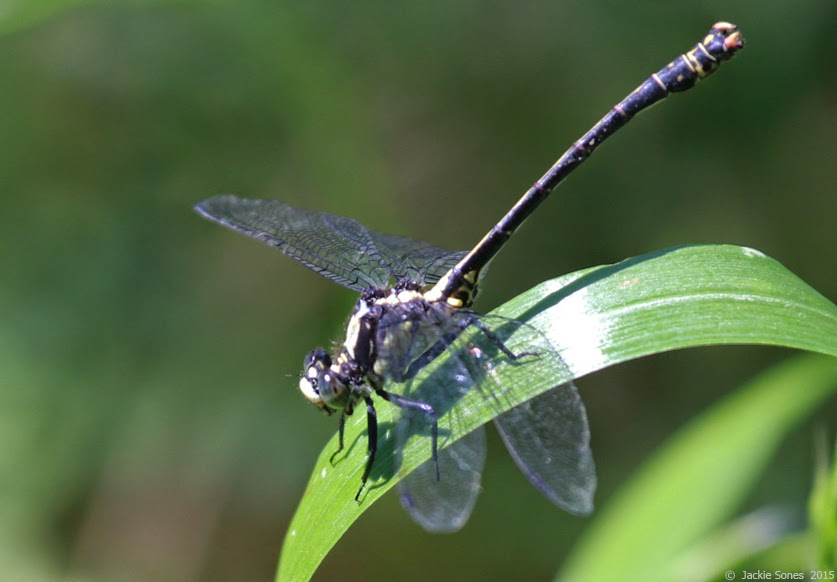This is a dragonfly I had been wanting to see for a long time, and I finally got around to finding out where to look for them (thanks to David!). Eric and I found a couple of sunny hours in between chores on Saturday and spotted these Grappletails (Octogomphus specularis) along Pine Flat Road in Healdsburg.
That's quite a name —
Grappletail. It stands out, and so does the reason for it —
the male's abdominal appendages are large and forked like grappling hooks (he uses them to hold onto the female when mating):
Now that you know what the appendages look like up close, you'll be able to spot them on perched individuals:
For important field marks, along with the distinctive appendages, some people look for an urn-like marking on top of the thorax, and widely spaced greenish-black eyes. These individuals also seemed to have quite a bit of blue-gray color in their eyes:
Although Grappletails are found in creeks and small rivers, Tim Manolis (Dragonflies and Damselflies of California) notes that females and nonbreeding males may be found away from the creeks at spring seeps, similar to where these individuals were photographed.
One thing that surprised me during my first encounter with this species was its behavior. I was glad that, when describing Grappletails, Sid Dunkle (Dragonflies through Binoculars) used the phrase "males perch unwarily..." While many clubtails are quick to fly off, we could walk right up to these Grappletails. In fact, you could easily walk by them without them flying — a very unusual behavior for a clubtail, in my experience.
I'm going to end with a quote by Clarence Hamilton Kennedy who wrote "Notes on the life history and ecology of the dragonflies (Odonata) of Central California and Nevada" published in the Proceedings of the U.S. National Museum (Volume 52) in 1917. I always like going back to these early papers because they're so descriptive — it's as if you were there, standing in the stream, watching dragonflies with Kennedy himself. You won't see writing like this in scientific articles or field guides now, but I'm glad it still exists in the early accounts:
"After having spent various days wading down mountain streams
observing Octogomphus more often than catching them, I was rewarded on July 7 by
seeing a female oviposit. She came volplaning down through an opening in the
canopy of alders and, while going through evolutions involving several figures,
8's and S's, she touched the surface of the pool lightly with the tip of her
abdomen at intervals of 2 to 6 feet. After 20 seconds of this, she airily
spiraled up and out into the sunshine, where she alighted on a bush on the
hillside above the creek."
We only observed male Grappletails this past weekend (as below), but now I can visualize the females, and hope to see them someday, too.







No comments:
Post a Comment